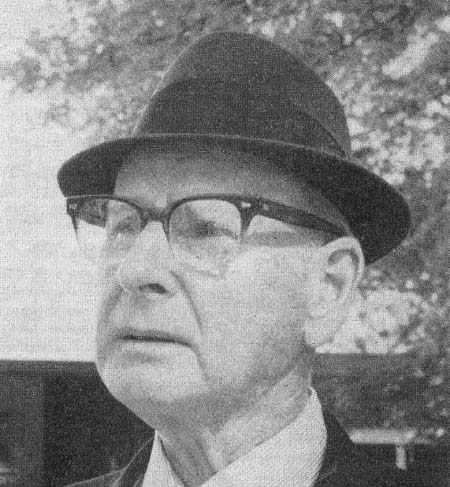Roland W. Paige
By Sonya Parry, Atlantic News Staff Writer
Atlantic News, Friday, November 7, 1995
[The following article is courtesy of Atlantic News]

[Atlantic News Courtesy Photo]
HAMPTON — The American Legion Post #35 in Hampton recently honored Roland W. Paige with a memorial dedication of its new hall in his name. Having heard about some of Rollie Paige’s many accomplishments, I set out to learn more about Hampton’s Extraordinary Citizen.
Ansell Palmer, a longtime resident of Hampton, became associated with Paige through the Historical Society.
“Hampton history was one of Paige’s main interests, so he was very active in the society,” Palmer said.
As a boy, Palmer knew Paige because he lived on Winnacunnet Road and Paige lived on Elmwood Farm, now an inn adjacent Landing Road, with his aunt. He walked by Palmer’s house often and was always a fine appearing man. He never made appearances without being very well dressed – coat, tie and his famous felt hat.
“He was a very meticulous dresser, he always looked perfect,” Irene Palmer added.
Paige always carried candy in his pocket, Ansell Palmer said, which he handed out to Hampton children, with whom he was very active.
Paige was active with Scout Troop #177, one of the original area troops. “He did a lot for the boy scouts,” Palmer said. The scouts would have paper drives before recycling became a town affair. Paige would help the scouts put paper into a trailer in the town parking lot.
“He’d have his sleeves rolled up and be in back of the truck right alongside the scouts,” Palmer said. Paige would even pick up papers if someone wasn’t able to get out.
“He never married, never drove a car,” Palmer said of Paige. Paige either took the bus to the Navy Yard where he worked, or managed some other way to get there.
Paige came to Hampton in 1919 when he was about 11 years old. He was born in Newburyport around 1910. It is said that he came to Hampton a motherless small boy to live with his aunt on Elmwood Corner, according to Palmer.
Paige attended Hampton Schools, and in 1925, Palmer noted, when he was at Center School, he was much impressed with the fact that Tuck Field and Historical area was dedicated. His class went down through the field to Tuck Museum to take part in the dedication.
“‘That’s probably where his interest began in Hampton history,” Palmer said. After attending Hampton Academy, Paige worked around town as a painter. World War II began to gear up and Paige went to work in the Navy Yard in Portsmouth in 1940 before war was declared.
“In the late ’30s, people knew we were headed towards something, and equipment in the yard was gearing up,” Palmer said. “Rollie didn’t go off to war with the rest of us since he was older.” Paige continued to work at the Navy Yard, but finally enlisted himself, was inducted at Ft. Devens and in the course of six months, he went from being a civilian into combat in Europe.
“It was really quite a change,” Palmer said. Paige’s outfit, the 623rd Army Corps of Engineers, was involved in the Battle of the Bulge. The outfit took some losses, but received a citation for their participation.
“He used to go to all the reunions,” Palmer said. “He is as much missed at them as by us here in Hampton for his involvement in activities.”
Paige got out of the service in 1945 and went back to work at the Navy Yard. He received a certificate for 30 years work, including his military service, and retired from the Navy Yard in 1970.
Paige was also active in the American Legion in Hampton. “He was the guy behind the scenes that was doing all the work.” Paige took care of the details, Palmer said, noting that “he was always the one after me to pay my dues.”
Paige was always visible in town at events like Memorial Day and Veterans Day parades. As the organizer of such occasions, Paige would get everyone, including the bands and the Legion, lined up.
“He would march, of course,” Palmer added. Paige was also involved I in these activities in North Hampton, I and Hampton Falls.
After moving into Hampton Village Apartments following the sale of his aunt’s farm in the early ’80s, Paige used to go across the street to the Galley Hatch to tab many of his meals, Palmer said. He considered the Tinioses, owners of the Galley Hatch, family. Sometimes they would even bring meals to his apartment if he couldn’t get out.
“One of the waitresses moved to Florida,” Palmer said, “and Rollie used to call her periodically.”
Roland W. Paige passed away in 1990, just days before he was to be present at the Galley Hatch Restaurant for a celebration in his honor. Events planned for the affair were later carried out at a memorial event.
Rollie Paige bequeathed everything he had to three organizations: the American Legion, the Cemetery Association and the Hampton Historical Society. Paige’s involvement in the Cemetery association consisted of the handling of all the cemeteries in Hampton.
Paige received a posthumous commendation as “Citizen Extraordinaire” from New Hampshire Governor Judd Gregg on March 15, 1990. He was recommended for this commendation due to his contributions to his community, state and country. It was read at a memorial service in his honor.
A fund was set up in Paige’s name in 1990 by the Hampton Historical Society through contributions by citizens to benefit the Greater Piscataqua Community Foundation. The fund’s purpose is to provide annual support for the “betterment of the Meetinghouse Green Memorial and Historical Association, Inc.,” now known as the Hampton Historical Society.